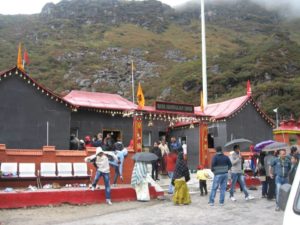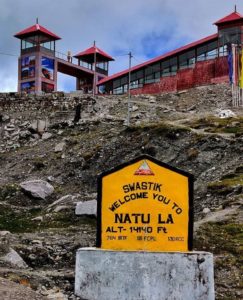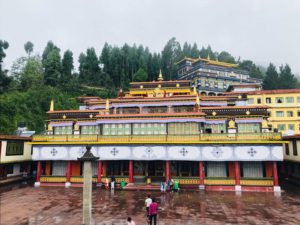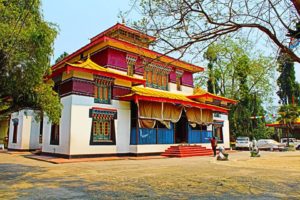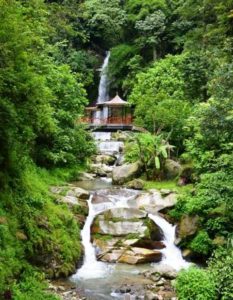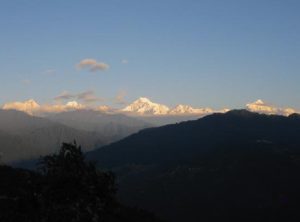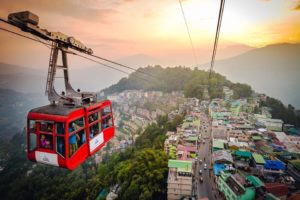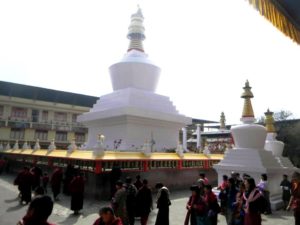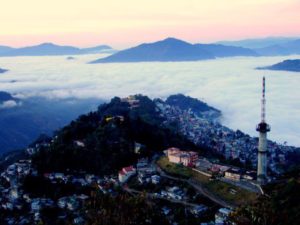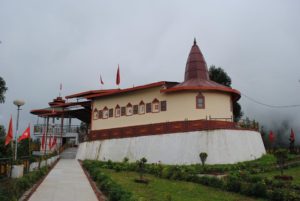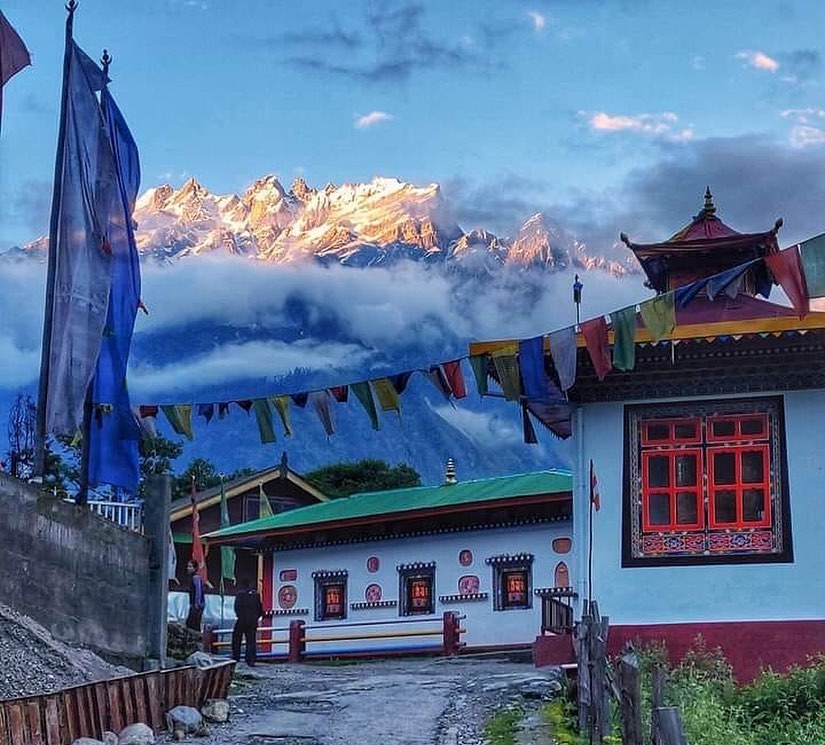Gangtok can be a dream destination for those who love anything and everything about mountains. Gangtok the Capital of the Sikkim is a modern hill resort with ancient spiritual beliefs and an impressive cultural heritage. Perched at a height of 5500 ft, it is offering a magnificent view of Mt. Kanchenjunga along with the other great peaks of the Eastern Himalayas at a distant skyline.
Gangtok is home to many famous attractions such as the Tsomgo Lake, Ban Jhakri falls, Rumtek Monastery and more. MG Marg, the main street of Gangtok is the heart of the town. An evening at M G Marg, sitting and relaxing on the various benches stretched across the mall, trying and tasting the delicious Sikkimese cuisines and enjoying the carnival like atmosphere, is an unforgettable experience. The M G Marg is lined with many traditional, contemporary and souvenir shops on both sides of the road, offering products that fit to every pocket and thus making shopping truly a pleasant experience.
ATTRACTIONS IN GANGTOK:
- Tsomgo Lake
Tsomgo Lake: the Tsomgo Lake is one of the many high-altitude lakes in Sikkim situated at an altitude of 12400 ft on the Gangtok – Nathu La highway. Located at a distance of 38 Kms from Gangtok this serene lake is about 1 Km long, oval in shape, 15 meters deep and is considered sacred by the local people. Popularly known as Changu Lake, it is a must visit destination of every tourist’s itinerary. Tsomgo Lake is a glacial lake that originates from the melting snows of the mountains around it.
- Baba Harbhajan Singh Temple
Baba Harbhajan Singh Temple or Baba Mandir: It is a distinguished “mandir” or shrine dedicated to “Baba” Harbhajan Singh, a soldier of the Indian Army who died near the Nathula Pass protecting the frontiers of India. It is situated between Nathu La and Jelepla Pass, at a distance of 64 km from Gangtok.
The soldiers of Indian Army and the locals believe that Harbhajan Singh comes to the temple every night and does his rounds after putting on his uniform. People worship him as a saint and believe that he guards the international boundary between India and China, over the last three decades and he is accomplishing this task alone.
Inside the Baba Mandir, one can see a large photo of Harbhajan Singh along with his other belongings like his neatly ironed uniforms and polished boots.
There are two shrines have been built to show tribute to Baba Harbhajan Singh. The old one has been built at the site of the bunker, where Baba Harbhajan was posted during his tenure and the new one has been built at a close proximity from Tsomgo Lake.
- Nathula Border
Nathula Pass: Considered as one of the highest motorable mountain passes in the world, Nathula Pass forms a part of an offshoot of the Old Silk Road. Even today the pass serves as an important trade link between India and China and indulges passing tourists in pretty much the same way as it once catered to traders and merchants.
This Indo-Chinese border post is nestled at an elevation of 14,140 feet and one can see the border gates of both countries and military bunkers lying across both sides of the border.
A road trip to Nathula Pass from Gangtok is a real treat for the eyes for the mountain lovers, as these roads come up with thrills and beauties in every curve. This is why the Nathula road trip should be in the travel bucket list of every tourists visiting Gangtok.
- Rumtek Monastery
Rumtek Monastery: Rumtek Dharma Chakra Centre or Rumtek Monastery: About 24 Kms away from Gangtok, is the Rumtek Dharma Chakra Centre popularly known as Rumtek Monastery which is one of the largest monasteries in Sikkim, belonging to the Kagyud order, one of the four major Tibetan sects of Buddhism.
Built by the 16th Gyalwa Karmapa in the 1960s the glorious Rumtek Monastery houses a beautiful shrine temple and a monastery for the monks which were established with the aim of spreading the Buddhist teachings around the world. It also houses some of the World’s most exquisite religious scriptures and rare traditional objects. A golden stupa and various other sculptures belonging to the 16th Karmapa have also been preserved at the monastery.
The magnificent shrine has a walkway around it on which the monks, pilgrims and visitors perform Kora (a circuit round of the monastery). The massive prayer hall inside the monastery is decorated with splendid murals, statues and thangkhas. Tourist can be present within the hall during the afternoon prayer ritual that starts at about 2:00pm. The prayer of the monks chanting, and playing religious musical instruments including drums, lutes, and horns is so mesmerizing and intense that can help you to experience the highest level of imperturbability.
- Enchey Monastery
Enchey Monastery: Literally known as ‘the solitary temple’, this 200 years old Buddhist shrine is a mystical wonderland surrounded with splendid natural beauty. Located at a close proximity to the Namgyal Institute of Tibetology, the Enchey Monastery is an important seat of the Nyingmapa order of Vajrayana sect of Buddhism. As per the belief, the Lama Druptob Karpo; a renowned tantric blessed with flying powers, flew from Maenam Hill and constructed a hermitage here. It had been renovated under the reign of Sidkeong Tulku (1909 1910). Today the monastery is home to 90 monks. The Monastery pays its reverence to Buddha, Loki Sharia and Guru Padmasambhava.
The Enchey Monastery is famous for its iconic Chaam dance; a special prayer offered by the masked monks, organized on the 18th, 19th day of the 12th lunar month of the Tibetan calendar. The monastery also celebrates the Pang Lhabsol festival that brings together the the Lepchas and the Bhutias.
- Ranka Monastery
Lingdum Monastery or Ranka Monastery: Lingdum Monastery, popularly known as Ranka Monastery lies in the East Sikkim some 20 km from Gangtok is one of the popular monasteries in Sikkim. Built in 1998. The monastery follows the Zurmang Kagyud lorder of Buddhism. Since it’s relatively a new monastery and does not have much historical or strategic significance like Rumtek Monastery, it is not much talked about.
However, due to its picturesque surroundings and beautiful architecture, the monastery attracts many Bollywood filmmakers here, and it has been a part of several Bollywood movies that have been shot here.
The monastery is spread out in a vast area with a 2-storey building along the periphery of the courtyard that has several classrooms where the young lamas undergo training. The visitors can easily interact with the young monks who are trained here.
The monastery is a good example of Tibetan architecture with a huge gold plated Buddha statue sits in the lotus position inside the sanctum. There are rows of low tables lying inside the sanctum where the lamas read their prayer books. One can visit the monastery during the evening prayer time when the monks chanting, and playing religious musical instruments thereby creating serene and spiritual atmosphere.
- Namgyal Institute of Tibetology
Namgyal Institute of Tibetology NIT: The Namgyal Institute of Tibetology was established in 1958 to promote and support research in the field of religion, history, language, art and culture of the people of the Tibetan cultural area including Sikkim. Built in the Tibetan architectural style amidst the lap of lush green nature, the NIT has a excellent museum and a library which houses one of the largest collections of Tibetan Tibetan iconography and religious art and literature books in the world outside Tibet, and a museum of. It has published the Bulletin of Tibetology since 1964 and numerous books over the years. Even though established primarily as a place for study and research of Tibetan and Buddhist culture, The Namgyal Institute has emerged as a major tourist attraction in Gangtok.
- Banjakri Waterfalls
Banjhakri waterfalls: En route to Ranka Monastery the Ban-Jhakri Waterfall is well known for its beautiful natural springs and pristine environment. This 100 ft waterfall is nestles in a thickly forested area of Swastik, which is about seven kilometers away from Gangtok. This beautiful waterfall gains its importance after the new tourist circuit emerges with the opening of the famed Ranka Monastery. Spread over an area of two acres of land, the waterfall cascades down with a lot of force and along with the Energy Park built specially for the tourists it becomes a prime attraction which should be on every travellers bucket list.
- Tashi View Point
Tashi View Point: Tashi Viewpoint is one of the prime tourist places in Gangtok which offers a get a view of the magnificent Mount Sinilochu and Mount Kanchenjunga. On a clear day one can also enjoy the spectacular views of Labrang Monastery and Phodong Monastery embedded amidst the lush green backdrop.. It was built by King Tashi Namgyal who ruled Sikkim between 1914 and 1963, Nestled in a pristine location, just 8 kms away from Gangtok town it also serves as a fabulous picnic place for local, as well as foreign tourists. The Sikkim Tourism has developed it as in ideal tourist spot with resting sheds, a park and a small cafeteria for visitors refreshments.
- Gangtok Ropeway
The Gangtok Ropeway: The Gangtok Ropeway is one of the prime tourist attractions in Gangtok which attracts thousands of tourists every year. Operational since December 2003, the ropeway has three terminal stations. The lower station is based in Deorali Market near to Institute of Tibetology. The mid-terminal is situated at Nam Nang, and the upper terminal is based just below Sikkim Secretariat. One can enjoy the stunning bird’s eye view of the city along with the majestic mountains and the valleys.
The cable car ride or the Gangtok ropeway opens from 9:30 am in the morning and closes at 4:30 pm in the evening and the duration of the ride is 1 km, a roundtrip is 2 kms.
- Do Drul Chorten
Do-Drul Chorten or Stupa: The Dro-Dul Chorten or Stupa is one of the most important Stupas of Sikkim. It was constructed by Trullshi Rimpoche, head of the Nyingma order of Tibetan Buddhism in 1945. It is situated next to the Namgyal Institute of Tibetology at Deorali.
A complete set of Dorjee Phurba, Kangyur relics (Holy Books) and other religious objects are kept inside the stupa. Around the stupa are 108 Mani Lhakor or prayer wheels. The stupa is surrounded by Chorten Lakahang and Guru Lakhang, where two statues of Guru Rinpoche are present. The Chorten was recently in news for the micaculous water dipping from its top on a clear sunny day.
A steep climb takes one to this holy place where one can witness the Buddhist monks live spending their days turning the wheels of Dharma and reciting prayer beads. The white Stupa with it’s gold halfmoon crest dominates the skyline of the area.
- Ganesh Tok
Ganesh Tok: Ganesh Tok view point is one of the many popular tourist attractions in Gangtok. Located at a distance of 6 Kms from Gangtok, it offers spectacular views of the snow capped Himalayan mountains. There is a small Ganesh Temple which is surrounded by colourful flags, tied across the stairs making it looks divine and serene. There is a lounge and a balcony in front of the temple which is the main attraction of the place.
- Hanuman Tok Temple
Hanuman Tok: Dedicated after the Hindu God- Lord Hanumana, Hanuman Tok is a popular temple and a major tourist attraction in Gangtok. It is located 11 kms from Gangtok,on the way to the Indo-Chinese border post of Nathula.
The legend says, Lord Hanuman took a rest at this point on his way to Lanka after collecting the Sanjeevani Booti (herb) to heal Lord Lakshman. The temple is situated at an altitude of 7200 feet; and thus providing a brilliant view of the surrounding mountains along with the famed Mount Kanchenjunga. The cremation ground of the erstwhile Namgyal Royal family of Sikkim is just next to this pristine place. Presently the temple and the surroundings are preserved and maintained by the units of the Indian Army.





